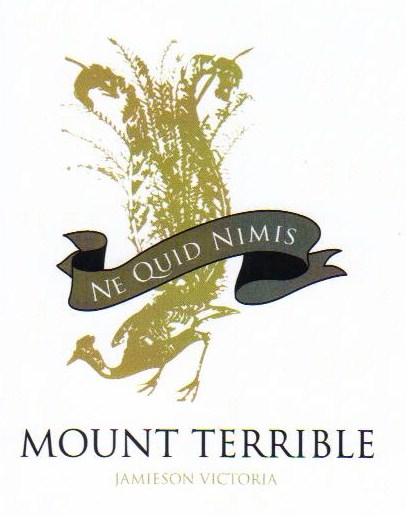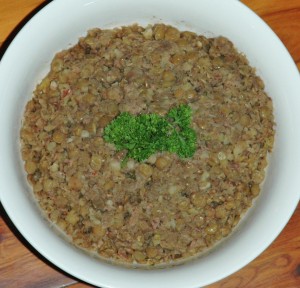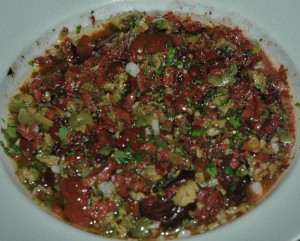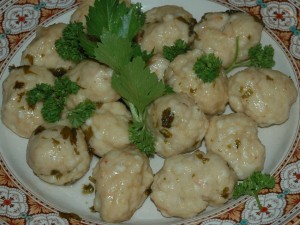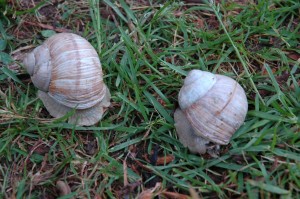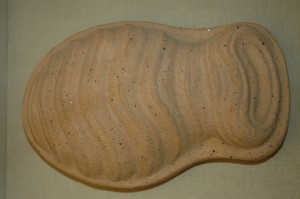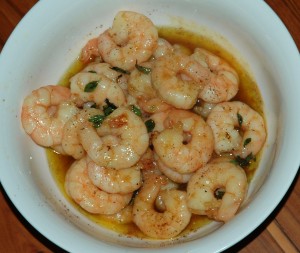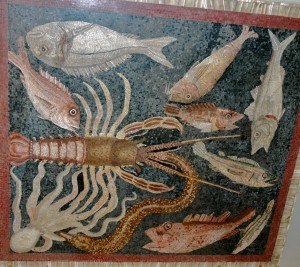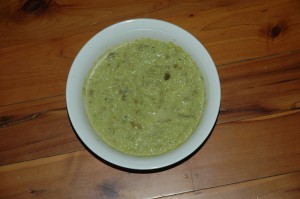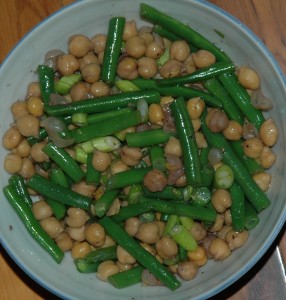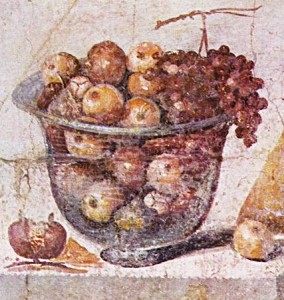Menus
This menu is intended to give an idea of what you might serve at a Roman Dinner Party. The selection of dishes arises from fifteen years of experimentation and reflects my personal preferences. For details of specific recipes, it is best to go to the original texts, most of which are available in English, and play around with them yourself. A quicker and easier course, however, is to visit one of the Websites which feature Ancient Roman Recipes, although purists may cavil about loose translation and some suggested substitutions (anchovy sauce for garum, date syrup for defrutum, tripe for sow’s uterus, squeamishness about brains … I could go on).
GUSTATIO: Gustatio or Promulsis was basically a selection of hors d’oeuvres or antipasto or tapas. As in a modern restaurant, some dishes can serve equally well as starters or mains. Choose from:
- Crudities made from celery, radish, spring onions, cucumber, mushrooms, green beans, asparagus and perhaps carrots (if you’re a stickler for authenticity, choose a white or purple variety).
- Dips such as Olive Relish (Cato De Agricultura CXIX), Olive and Celery Pate (Columella in Grant 2nd edn p70), and Cheese and Herb Puree (Columella De Re Rustica XII lix), served with Crusty Italian Bread.
- Hard boiled (chicken, pheasant, duck or goose) eggs, served with a sweet, sour and salty sauce Apicius VII xix 3
- Olives (a selection of deli Greek and Italian olives is satisfactory)
- Artichokes boiled and dressed with pepper, cumin, garum and oil Apicius III xix 3
- Pickled Cucumber, Lettuce and Mushrooms.
- Pickled Cheese (Bassus Country Matters in Grant 2nd edn p73) or buy Pickled Feta.
- Hard Cheese such as Pecorino
- Smoked Fish such as Mackerel
- Grilled Crayfish with herb sauce Apicius IX i 2
- Oysters served au naturel with a pepper, lovage, parsley, cumin, honey, vinegar and garum sauce Apicius I xv 2
- Seafood rissoles Apicius II i 1
- Mussel rissoles Apicius II I 6
- Mushrooms in wine Apicius VII xv 4
- Snails Apicius VII xviii 2
For that finishing touch I would love to add Stuffed Roast Dormice – Apicius VIII ix – but investigations so far suggest dormice are not available in Australia.
‘Dinner Delayers’ like the above were commonly served with a chilled Mulsum Aperitif. Chilling white wine was achieved both by packing small wine-jars in ice and straining wine through a sieve containing crushed ice. The ice was transported in large chunks down mountains in winter, then packed in straw and buried in pits until it was needed in summer: in consequence cold wine was something of a luxury.
MENSA PRIMA; the Caput Cenae or Head of the Dinner. In the absence of rice and potatoes and pasta, I find the easiest way to achieve a balance between meat or fish, vegetables and bread is to serve a variety of dishes simultaneously and let guests help themselves to whatever they like.
Meat: – Sucking Pig roasted a la Vitellius (cooked in a sauce of pepper, lovage, garum, wine and passum) Apicius VIII vii 7
- Smoked Lucanian Sausages (peppery sausages flavoured with traditional Roman herbs and spices) Apicius II iv
- Pork and Apple Stew (Minutal Matianum, a typically Roman dish where a wide range of unusual ingredients achieve a sweet and sour effect) Apicius IV iii 4
- Ofellae in the style of Ostia (marinated roast belly pork with a sweet wine sauce) Apicius VII iv 1
- Ham in a red wine and fennel sauce (hot slices of ham with a sweet and sour sauce) Heidelberg Papyrus trans Grant, Roman Cookery 2nd edn, p117
- Stuffed Sow’s Matrix (Apicius II iii 1) with Apician sauce (Apicius VII i 2). A dish esteemed by Emperors, the idea of eating wombs is repellent to modern tastes, and the serving of offal designated unfit for human consumption would probably attract prosecution in Australia. If this isn’t enough to put you off, best get uteruses from your neighbourhood abattoir rather than harvesting them in the authentic Roman fashion (Pliny: VIII li (209) sows are spayed in the same way as also camels are, by being hung up by the forelegs after two days without food and having the matrix cut out; this makes them fatten quicker).
- Beef casserole (beef marinated and cooked very slowly in vinegar, wine, honey and spices) Anthimius On Foods trans Grant, Roman Cookery 2nd edn p114
- Roast Hare Apicius Viii viii 1.
- Roast Venison with two sauces Apicius VIII ii 4 and 8.
- Marinated Roast Lamb Apicius VIII vi 7
Poultry: – Chicken a la Fronto (braised with garum, herbs and defrutum) Apicius VI ix 12
- Chicken stuffed with minced meat, brains and herbs Apicius VI ix 14
- Parthian Chicken (braised in wine and asafoetida) Apicius VI ix 2
- Sala Catabia (a potted layered bread and chicken salad) Apicius IV i 2
- Twice cooked Duck with Turnips (this is a sensational dish very similar to Canard roti avec Navets) Apicius VI ii 3.
- Roast Duck with Damson Sauce Apicius VI ii 2
- Boiled Goose Apicius VI viii with Nine Times Sauce (a bread sauce recipe from Ausonius, Epigrams XIX xx. Just the thing if you fancy you’re Catullus and are looking for something to set you up for ‘novem continuas fututiones.’)
Seafood: – Honey-glazed Shrimps (an excellent, faintly oriental dish, created on slightly thin evidence from Philoxenus by Dalby and Grainger). Classical Cookbook p 48
- Minced Crayfish tail balls (this is a magnificent, not to mention cripplingly expensive, dish. The principal reason for its inclusion here, however, is that it gives me the chance to quote Barbara Flower and Elizabeth Rosenbaum’s mischievous mistranslation of Apicius’s instructions to the cook, ‘Folium noci uvam prius demes,’ which they would have us believe means ‘Remove first the harmful scrotum.’ Apicius IX i 4
- Mussels steamed with leek, garum and wine Apicius IX ix
- Grilled Tuna with a herb, oxymel and wine sauce Apicius IX x 5
Vegetable Dishes: this, in my opinion, is where the biggest hole appears in Roman cuisine. The best way to cope with the lack of potatoes, pasta, rice and tomatoes is to make sure there’s plenty of nice crusty bread and lavish maximum effort on a wide selection of small, tasty side-dishes.
Chosen from:
- Lettuce and Endive dressed with garum, oil, wine and onion Apicius III xviii 2
- Boiled Baby Asparagus dressed with oil and salt. Or Asparagus Patina (a delicate asparagus flavoured omelette) Apicius IV ii 5, 6
- Green Beans boiled then tossed in salt and olive oil
- Artichokes dressed with pepper, cumin, garum and oil Apicius III xix 3
- Leek dressed with oil and oenogarum Apicius III x 1
- Carrots with cumin sauce Apicius III xxi 3
- Cucumbers braised in oil and oxymel
- Celery Puree Apicius III xv 2
- Cabbage with oenogarum, oil and herbs Apicius III ix 3
- Athenian Cabbage (dressed with coriander, rue and oxymel) Oribasius Medical Collections IV iv 1, in Dalby and Grainger, Classical Cookbook p40
- Spring Cabbage with cumin, Apicius III ix 1
- Baby Beets in mustard, oil and vinegar Apicius III xi 2
- Lentil and Red Wine stew (Laganophake) Heidelberg Papyrus trans Grant, Roman Cooking 2nd edn p131
- Green Lentils with Chestnuts Apicius V ii 2
- Chickpea and Green Bean salad Apicius V viii 1
- Chickpeas and Cheese Galen On the Power in Foods, in Grant, 2nd edn p142
- Vitellian Peas (mushy peas with honey, wine, garum and vinegar) Apicius V iii 5
- Mushrooms in honey, oil and garum (this is a great dish, very reminiscent of Chinese Honey-Glazed Mushrooms) Apicius VII xiii 6
- Truffle Kebabs (for the modern cook an outrageously unaffordable dish unless he is in the happy situation of the local truffle farmer liking his Pinot) Apicius VII xvi 2
MENSA SECUNDA: a selection of nuts, fruits and cakes basically. A chance to rest on your laurels after the exertion of the first two courses. Successful desserts include:
- Cheese and Sesame sweetmeats Cato De Agri Cultura 79
- Melon with mint dressing (can also be used as a starter but I think better here) Apicius III vii
- Patina of Pears Apicius IV ii 35
- Itrion (Honey and sesame biscuits) a very ancient recipe described in Athenaeus’ Deipnosophistae and adapted by Grant, Roman Cookery, 2nd edn. p54
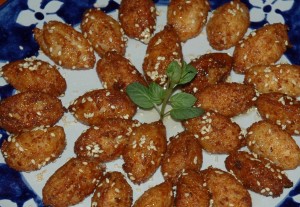
- Honey cake described in Athenaeus and adapted by Grant, Roman Cookery, 2nd edn. p144
- Honey nut cake described in Athenaeus and adapted by Dalby and Grainger, Classical Cookbook p80.
